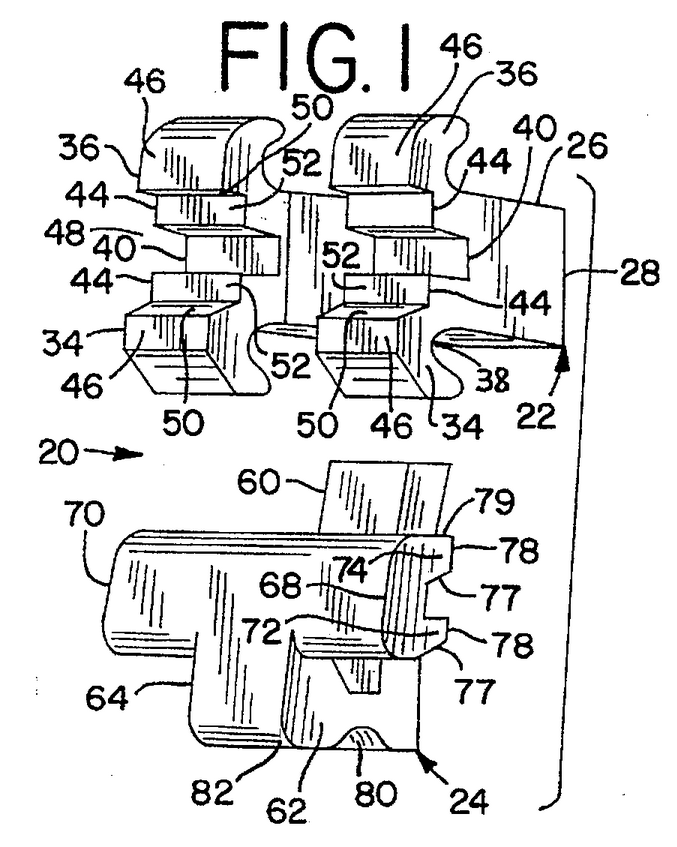OrthoArm Incorporated v GAC International, LLC, 2015 ONSC 5097
The Ontario Superior Court of Justice (“the ONSC”) was called upon to perform US patent claim construction to decide whether a United States patent (U.S. Patent No. 5,630,715) owned by OrthoArm Incorporated (“OrthoArm”) covered certain dental products sold by a licensee, GAC International (“GAC”). OrthoArm had originally licensed the ‘715 Patent to GAC for the sale of a OrthoArm’s self-ligating orthodontic bracket, [14] but GAC acquired new technology that it contended puts its new product outside the scope of the earlier patent and licensing agreement. [17] OrthoArm disagreed, arguing that the new technology was still covered by ‘715 Patent. [19]

OrthoArm’s US patent claim construction
In order to decide the case, the ONSC had to determine certain matters of US Patent law as fact through expert witnesses. The two experts, Marguerite Ethier and Lawrence Goodwin, agreed on the relevant US patent law principles, but disagreed on the proper construction of the ‘715 Patent and whether GAC’s new product infringes. [22] Ultimately, the Court determined that GAC’s new product did not fall within the claims of the ‘715 Patent and was therefore not subject to the OrthoArm-GAC license. [70]
US Law on Patent Infringement
The ONSC recited principles of US patent infringement law, including the “Markman hearing” process of claim construction, [30] and a list of the principles that are relevant to claim construction in the US. [34] The ONSC was to undertake the analysis that would normally be done at a Markman hearing: to construe the relevant claims and apply that construction to determine whether there is infringement. [31]
Construction of the ‘715 Patent
At issue was the interpretation of four key terms in the ‘715 Patent. [41] The ONSC’s analysis of the meaning of two of these terms exemplifies the ONSC’s approach to claim construction.
The first key term was a directional term. Claim 29 claimed a bracket with a base having an “occlusal-gingivally extending opening”. [42] It was agreed that occlusal was understood to refer to the direction toward the mouth opening, and gingivally was understood to mean toward the gums. [44] Assuming the patient was sitting upright, these terms meant generally up and down. [44] What the ONSC needed to determine was whether claim 29 required the base to have an opening that is absolutely up or down, or whether it allowed for some degree of variance in the direction of the opening. [46]
The ONSC considered the figures in the specification, which showed some variance in the orientation of the opening, [47] the lack of limiting terminology in the specification, [48] the expert testimony that people’s teeth sit in the mouth at different angles, [49] and considered the suffix “-ly” on “gingivally” to imply a more general requirement, [49] all to determine that the “occlusal-gingivally” directional requirement did allow for some variance. [47-50] Although the ONSC did not say explicitly that the person skilled in the art would interpret these terms in this way, it did acknowledge that the experts that it relied on had skill in the art. [38]
A second key term is another directional term. Claim 1 claimed “a slidable locking shutter moveable between open and closed positions”. [56] The ONSC needed to determine whether the movement between open and closed positions needed to be be entirely a sliding motion or whether the claim could capture a motion that includes some rotation as well. [58, 61]
Looking to definitions in the specification, [59] figures showing the open and closed positions, [59] and taking a “common sense construction” of this aspect of the claims, [60] the ONSC found that “the sliding motion needs to be from the open position to the closed position, not just for a part of the movement.” [60] GAC’s new product, on the other hand, contains a locking shutter that operates by a sliding motion part of the way, but mainly employs a rotating motion to move the lock from an open to a closed position. [62] Since there is not a sliding motion from the open to closed position, Claim 1 could not capture GAC’s new product.
The ONSC’s basis for applying “common sense construction” can be found in its understanding that the patent specification is “usually the primary basis for construing claims” and the specification allows the court to apply “common sense” to its construction. [37] It is unclear, again, if the ONSC is construing the claims from the perspective of of the person skilled in the art, which is bedrock claim construction in Canada. Some connection between the ONSC’s “common sense construction” and the skilled person’s perspective can be found in its list of relevant claim construction principles:
(iv) the ordinary and customary meaning is the meaning that the term would have to a person of ordinary skill in the art in question at the time of the invention;
(v) in some cases, the ordinary meaning of claim language as readily understood by a person of skill in the art may be readily apparent even to lay judges, and claim construction in those cases involves little more than the application of the widely accepted meaning of commonly understood words; … [emphasis added]
Since all of the claims of the ‘715 Patent include this claim element, GAC’s new products do not infringe the ‘715 Patent and therefore are not be covered by the OrthoArm-GAC license. [64, 70]
Commentary
An Ontario court doing an infringement analysis on a US patent is a rare occurrence. Foreign law is a question of fact, so the ONSC’s interpretation of US law is of limited persuasive value. However, this case still serves as a useful example of how a Canadian court that does not normally deal with patent law in Canada interprets American patent law.
